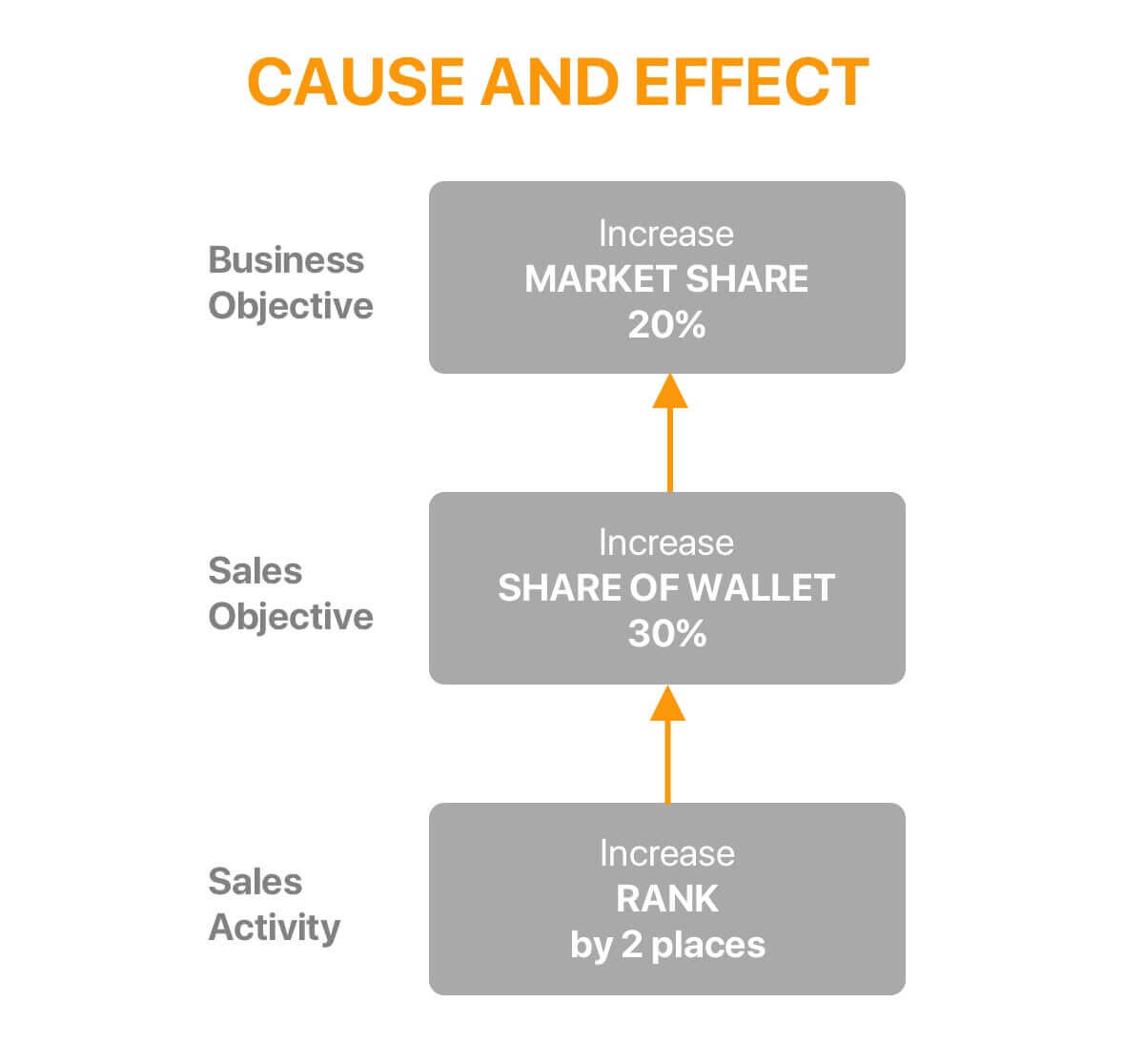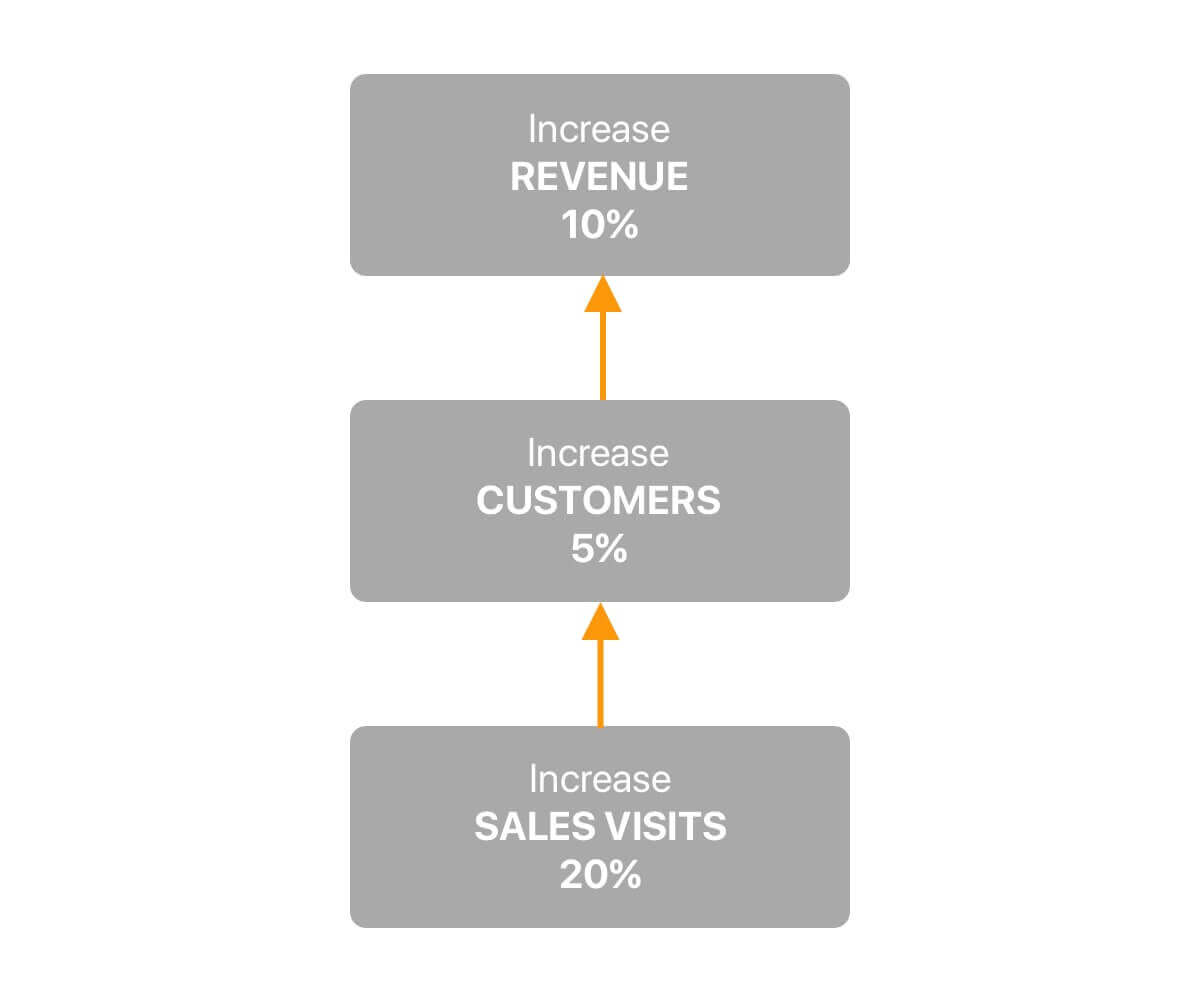Product
Features
column
column
Add-ons
Integrate
Custom Versions
Customers
By Industry
By Role
Success Stories
column
column
Pricing
Resources
Product Support
Education Resources
section
5 min read
Everybody understands that setting goals for sales reps is pretty much mandatory. They are the necessary incentives pushing your field reps to the limit, guiding them towards whichever sales objective you have targeted for the given quarter.
Without them your team loses focus and direction.
But the real challenge is picking the right goals for sales reps. With the improvement of mobile CRM technology over the past few years, there’s now so much data available to field sales managers they can find themselves drowning in metrics: revenue, share of wallet, profit, customer satisfaction, prospecting calls, sales activity, call time…
It can be extremely overwhelming!
I mean, how do you decide where to focus your efforts?
Thankfully there’s a system in place that now only allows you to not only wade through the metrics and select the premium goals for sales reps but also ensures they’re tightly linked back to your overall business objectives.
That way you can be confident that every sales action undertaken by your field sales team is focused towards a specific business goal.
Before diving into the “how” to set any goals for sales reps you must consider the SMART strategy.
Every and all goals set should follow this basic principle:
Specific
Measurable
Achievable
Relevant
Time-sensitive
The better you can define what you actually want to achieve, quantitatively as a sales manager, the more likely you are to achieve it. For example, if your sales objective for the upcoming quarter is to increase revenue, but a figure next.
By how much would you like to increase revenue? By when? And How? The more specific you can be when defining sales goals the more likely your team are to hit them.
“What you cannot measure, you cannot improve.”
This famous business phrase coined by Peter Drucker (or possibly Lord Kelvin, depending on what you read) remains as true now as it did back then, especially concerning goals for sales reps.
If there’s no quantitative yardstick for which your field sales reps can be measured against there’s no way in knowing whether they’ve been successful or not.
This one is fairly straightforward – are the goals you set for your field sales team realistic? For example, if you ask them to increase prospecting calls by 20%, it’s important you consider or not they have the time and resources necessary to achieve it.
Setting unrealistic, unachievable goals can be incredibly demotivating for sales reps and certainly won’t help in them achieving your overall business objectives.
This goes without saying but the goals you set must be relevant or at least tied to some objective. Going back to the prospecting example, we can assume this target was set as the objective was to increase business acquisition for the quarter.
Increasing one will directly cause an increase in the other.
Asking your field sales team to spend more time with their existing customer base, on the other hand, would not be a relevant sales goal.
Increasing time with existing customers is not directly tied to new business acquisition (referrals aside of course, but you get my point!)
Time is money my friend!
Putting a deadline on a sales goals is what gets the sales team moving. Think about the end of quarter rush as your team frantically tries to clear out the pipeline in a last-ditch effort to snatch that bonus check before it blows away into the next quarter.
It obviously needs to be somewhat realistic (as we alluded to earlier) but also challenging – if not there’d be no incentive to hustle throughout the quarter if they knew it was achievable by just dawdling along.
Before we look at the system we first have to understand the inherent problem most field sales managers face when setting goals for sales reps.
Over the 30 or 40 year a technological revolution took place; the trusty Rolodex and mainframe CRM were replaced by the smaller, smarter, mobile sales technology. As a result, the amount of data available to field sales managers has reached levels unprecedented in sales management history.
But all this data can leave field sales managers somewhat stunned. How do all these data points work together? If I wish to increase this figure, do I tamper with this number or that data point?
How does this all work!
It has given us the visibility to see what is happening but without the instruction manual with which to act upon it. As a result, field sales managers often revert to the “old way” of setting goals for sales reps which is simply, here’s your quota for next quarter, that’s your goal.
But it’s rough, vague and doesn’t explain how they are supposed to achieve it.
So how do you effectively spot the wood from the trees? As field sales managers you can’t manage numbers, it’s a physical impossibility. What you can do, however, is to manage people or more specifically the goals you assign to them.
For example, we can’t magically control the speed at which we run at. There’s no dial that can be turned clockwise in our favor (unfortunately).
What is manageable though is the amount of time spent in the gym or the running track which could, in turn, lead to an increase in speed. It therefore becomes vital to establish cause and effect when deciding on certain goals for sales reps.
You must start with your desired end goal. Once that has been established, you decide one by one look at the specific sales objectives that will help you reach the desired goal
And once that has been done, you can then establish which specific sales activities directly affect the required sales objectives. These tangible activities are what you use to create goals for sales reps.
Let’s look at an example.
Imagine your field sales team was focused on customer retention as the majority of your sales came from existing clients, a desired business objective therefore could be to increase market share. Using the suggested cause and effect model we now have to find a correlating sales objective. In this case a tried and tested method for increasing market share is share-of-wallet i.e. the percentage of business you receive compared to your competitors
But that’s not enough, to effectively set goals for sales reps we need to determine a specific sales activity. Something SMART.
Now an activity that directly affects share-of-wallet is customer ranking – where a customer places you in terms of loyalty and satisfaction against competitors. Your sales activity is therefore to increase rank:

If our field sales team is geared more towards “hunting” than “farming”, then the same concept still applies.
Our business objective might to increase revenue. Again, this is a little vague and we can’t just assign our field sales reps a quantitative quota and send them out the door. What we need is a sales objective.
If we are managing a hunter style field sales team, then a common method in increasing sales revenue is to bump up the number of customers attained for that quarter. But we are not done there!
We still need to ascertain how we can get more customers on board – our sales activity. In this case, we could decide to set our reps something tangible such as increasing the number of visits or appointments made to prospecting leads:

As you can see this method not only ensures the goals for sales reps are measurable, so can be tied back to performance and sales coaching, but are directly related to the end target you have in mind. More importantly they are broken down into manageable, tangible, bitesize pieces that your field sales reps can go tearing after to help achieve your business objectives.
Now we’ve established which goals to set and why, it’s time look at how you can implement goals into their daily routine.
One suggested method is took look at mobile sales software such as GoalManager.
Used as an add-on to your mobile CRM, this goal-incentivizing platform is interlinked with your sales KPIs. This means that as a field sales manager, you can:
What’s more, because all this information is centralized within the CRM you are able to effectively pinpoint areas for improvement too. If a sales rep is consistently falling short of their assigned sales goals, you now have a clearer picture to ask the question why?
Is it down to poor time management? Lack of confidence or success in face-to-face visits? Too much time spent with “comfortable” clients?
Whatever the answer, as a field sales manager you know have the visibility with which to act upon.
If you want this level of clarity and confidence in reaching your business goals…